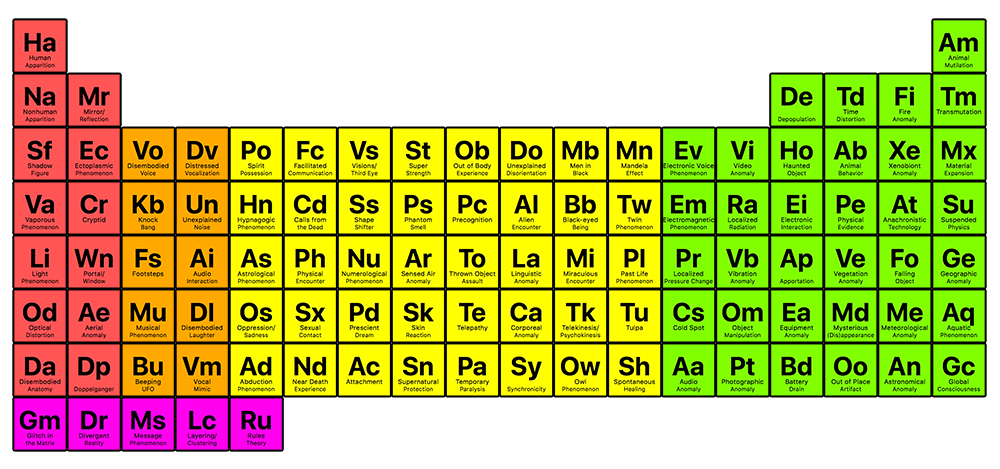 The Periodic Table of Paranormal Elements was created by paranormal researchers Jill and Roger Pingleton as a way of categorizing and analyzing a broad spectrum of paranormal phenomenon. While examining the various fields of paranormal study, they discovered many similarities between separate cases, yet there seemed to be little work which attempted to explain these similarities or tie them all together.
The Periodic Table of Paranormal Elements was created by paranormal researchers Jill and Roger Pingleton as a way of categorizing and analyzing a broad spectrum of paranormal phenomenon. While examining the various fields of paranormal study, they discovered many similarities between separate cases, yet there seemed to be little work which attempted to explain these similarities or tie them all together.
Even worse, it seemed many researchers in individual fields of study (Ufology, Cryptozoology, etc.) often discounted the evidence of other researchers and/or denied any connection between the various fields of study.
The researchers wondered if, by categorizing phenomenon into discrete elements, they could gain a greater insight into the whole of anomalous research and possibly reach an understanding which has, as of yet, proven incredibly elusive.
The Table Layout
The table is divided into five distinct categories of anomalous phenomenon, each represented by a color:
Visual Elements are red. These Elements represent phenomena which are primarily experienced through the visual senses.
Auditory Elements are orange. These Elements represent phenomena which are primarily experienced through the auditory senses.
Physiological Elements are yellow. These Elements are primarily related to human physiology and are experienced physically. These are also commonly referred to as personal experience.
Environmental Elements are green. Unlike Visual, Auditory, and Physiological Elements which are qualitative in nature, Environmental phenomenon can generally be measured using scientific equipment and methodologies and are thus quantitative in nature.
Super Patterns are purple. Unlike the other four categories of Elements, Super Patterns contain other Elements and represent theories which attempt to tie other Elements together.
Principle Design Goals
While creating the Periodic Table of Paranormal Elements, a great deal of thought was put into the various categories of anomalous phenomena. When deciding upon the structure of the table and the inclusion of specific Elements, the following goals were established:
1) With the exception of Super Patterns, the subject matter of an Element should be discrete when broad terms fail to describe specific aspects of a phenomenon or when various phenomena cannot be definitively tied to together. As a way of example, what is commonly referred to as Extrasensory Perception (ESP) was not included in the table of Elements because generally it includes the phenomena of Telekinesis/Psychokinesis, Precognition, Visions/Third Eye phenomenon, etc., all of which are subjects unto themselves, and none of which can be definitively tied together as a whole. Thus while ESP is convenient for categorizing these Elements, it was determined to be too general to be included as an Element.
2) While specificity is preferred when generalities fail to tie phenomena together, generality is preferred when a subject is so broad that breaking a phenomenon down into individual cases would produce a large number of Elements which would essentially describe the same phenomenon. For instance, within the field of Ufology, sightings and types of craft vary greatly, and yet it is their commonalities that tie them together under the Element of Aerial Phenomenon. That said, when a craft is observed to be a light with no physical shape, this might better be classified as a Light Phenomenon. Likewise when a craft accelerates at a rate which should be physically impossible, a researcher should consider whether this falls under the Suspended Physics Element.
3) An element should be singular in nature. An element should be able to describe a specific instance of a paranormal event. As such, the word phenomenon is preferred to phenomena, and the word anomaly is preferred to anomalies. Exceptions have been made when an instance of an element is defined by its plurality. For instance, a single footstep could easily be considered to be a knock/bang, while footsteps describe a progression of noises which distinctively describe a single occurrence.
4) The Periodic Table should evolve as more evidence is discovered and/or more discussion and analysis occurs.